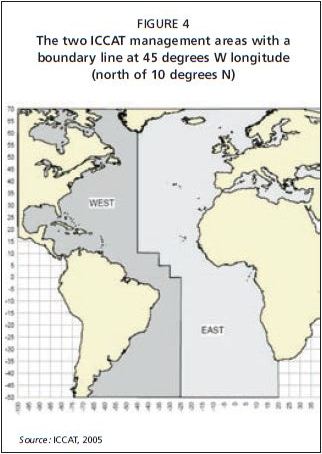BLUEFIN TUNA FISHERIES
Thunnus thynnus is the most demanded and expensive tuna species. The fishery is regulated by the International Commission for the Conservation of Atlantic Tunas (ICCAT) which is responsible for the conservation of tunas and tuna-like species in the Atlantic Ocean and adjacent seas. Since 1982 the Commission has managed Atlantic bluefin tuna in two areas with a boundary line at 45 degrees W longitude (north of 10 degrees N) (Figure 4).
As a result of overfishing, beginning in 1982 the fishery in the Western Atlantic management area has been controlled by restrictive catch limits. Catch limits have been in place for the Eastern Atlantic and Mediterranean stock in 1998. The Commission established a total allowable catch (TAC) for both stocks.
The Thunnus thynnus global catch shows a considerable yearly reduction. In 1996 it peaked at 52 664 tonnes and dropped to 31 577 tonnes by 2004 as a result of the ICCAT quotas (Figure 5).
However, the Standing
FIGURE 4
The two ICCAT management areas with a boundary line at 45 degrees W longitude (north of 10 degrees N)

Source: ICCAT, 2005
Committee on Research and Statistics (SCRS) of the Commission affirms that considerable over fishing still goes undetected.
According to the ICCAT global catch statistics for the Western Atlantic tuna stock from 1995 to 2004, the lowest catch was recorded in 2004 at 1 644 tonnes, while the highest was in 1999 at 3 550 tonnes. For the Eastern Atlantic stock, the lowest catch was reported at 29 933 tonnes in 2004 and the highest at 50 274 tonnes in 1996 (Figures 6 and 7).
Thunnus thynnus is captured using a variety of gear types including purse seines, longlines, traps, handlines, bait boats and sport fishing. Since the 1990s, as the majority of the catch has been destined for farming purposes, the capture is mostly carried out by purse seine that allows the capture of live individuals. Minor quantities are still harvested using tuna traps. The major catch area for the Atlantic bluefin tuna is the Mediterranean Sea where 73 percent of the global catch is landed, followed by the Northeast Atlantic (15 percent). The majority of
Figure 5
Thunnus thynnus global catch from 1995–2004
Figure 6
Thunnus thynnus Western Atlantic global catch from 1995–2004
Figure 7
Thunnus thynnus Eastern Atlantic (incl. Mediterranean and Black Sea) global catch from 1995–2004
187
the Mediterranean catch is destined for farming operations (Figure 8).